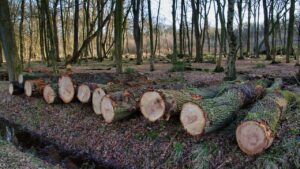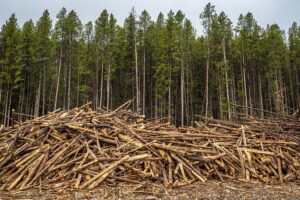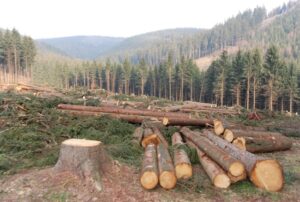Introduction
Deforestation is the process of clearing or removing large areas of forests or trees, typically for various human activities such as agriculture, logging, urban development, or mining. It has significant environmental impacts, including habitat loss, reduced biodiversity, disruption of ecosystems, and contributing to climate change by releasing stored carbon dioxide into the atmosphere. Deforestation also has social and economic consequences, often affecting local communities and indigenous peoples who rely on forests for their livelihoods. Efforts to address deforestation include conservation initiatives, reforestation, and sustainable land use practices.
Effects of Deforestation.
Deforestation is a serious environmental issue with far-reaching consequences for our planet. The effects of deforestation are wide-ranging and affect everything from climate to biodiversity, water resources and human livelihoods.
1. Climate Change
One of the most significant and widely recognized effects of deforestation is its contribution to climate change. Trees act as carbon sinks, absorbing carbon dioxide (CO2) from the atmosphere during photosynthesis and storing it as biomass. When trees are cut down and forests are cleared, this stored carbon is released back into the atmosphere as CO2, contributing to the greenhouse effect and global warming.
2. Loss of Biodiversity
Forests are home to a vast array of plant and animal species, many of which are unique and cannot be found anywhere else in the world. Deforestation disrupts these ecosystems, leading to habitat loss and fragmentation, which can result in the extinction of numerous species. It’s estimated that a significant portion of the world’s biodiversity is at risk due to deforestation.
3. Disruption of the Water Cycle
Forests play a crucial role in regulating the water cycle. They absorb rainwater, store it in the soil, and release it slowly over time. Deforestation disrupts this cycle, leading to increased runoff, soil erosion, and reduced water quality. This can have severe consequences for both local communities and downstream areas.
4. Soil Degradation
Forests help maintain soil fertility by providing organic matter and preventing erosion. When trees are removed, the soil is exposed to sunlight and rain, which can lead to rapid degradation. This makes it challenging to sustain agriculture and can result in long-term damage to the land.

5. Increased Greenhouse Gas Emissions
Beyond the immediate release of carbon stored in trees, deforestation also leads to increased emissions of other greenhouse gases, such as methane and nitrous oxide. These gases are released from the decay of organic matter in the soil and can further exacerbate climate change.
6. Impact on Indigenous Communities
Many indigenous communities depend on forests for their livelihoods, cultural practices, and traditional knowledge. Deforestation often displaces these communities, disrupts their way of life, and can lead to social and economic challenges.
7. Reduced Medicinal Resources
Forests are a source of numerous medicinal plants, and many communities rely on these resources for traditional medicine. Deforestation can lead to the loss of valuable medicinal plants and disrupt healthcare practices.
8. Increased Risk of Natural Disasters
Forests provide natural buffers against natural disasters such as floods, landslides, and wildfires. Their removal increases the vulnerability of nearby communities to these events.
9. Loss of Ecosystem Services
Forests provide a wide range of ecosystem services, including air and water purification, pollination of crops, and recreational opportunities. Deforestation diminishes these services, leading to negative impacts on human well-being.
10. Economic Consequences
While deforestation may provide short-term economic gains through timber extraction or land conversion for agriculture, the long-term economic consequences can be severe. Loss of ecosystem services, reduced agricultural productivity due to soil degradation, and the costs of mitigating climate change can outweigh the immediate economic benefits.
Reasons for Deforestation
1. Agricultural Expansion:
One of the primary drivers of deforestation is the conversion of forested land into agricultural fields. Growing populations and increasing food demands have led to the clearing of forests to make way for crops and livestock.
2. Logging and Timber Extraction:
The timber industry is a major contributor to deforestation. Trees are cut down for their valuable wood, leading to extensive forest degradation.
3. Infrastructure Development:
The construction of roads, highways, and urban areas often requires clearing large areas of forests. This infrastructure development opens up previously inaccessible forested regions.

4. Mining Activities:
The extraction of minerals and resources, such as oil, gas, and minerals, often involves clearing forests and can result in long-term environmental damage.
5. Forest Fires:
Natural and human-induced forest fires can devastate large forested areas, causing immediate deforestation and contributing to long-term ecological disruption.
6. Commercial Agriculture:
Large-scale commercial agriculture, including palm oil and soybean plantations, is responsible for significant deforestation, particularly in tropical regions.
7. Urbanization:
Rapid urban growth leads to the expansion of cities and towns into nearby forests, resulting in deforestation and habitat destruction.
8. Climate Change:
Climate change-related factors, such as increased temperatures and altered precipitation patterns, can stress forests, making them more vulnerable to pests and diseases, which can ultimately lead to deforestation.
9. Illegal Logging:
The illegal logging industry is a major threat to forests, as it often operates without regard for sustainable practices or conservation efforts.
10. Land Ownership and Land Tenure Issues:
In many regions, unclear land ownership and tenure rights can lead to disputes and conflicts over forested land, often resulting in deforestation.
Each of these reasons for deforestation varies in significance depending on the region and the specific circumstances. Addressing deforestation requires a combination of policy measures, sustainable land-use practices, and international cooperation. Conservation efforts and reforestation programs are also essential to combat the ongoing loss of forests and their vital ecosystems.
Ways to Combat Deforestation
1. Reforestation and Afforestation:
Reforestation and afforestation are essential strategies to combat deforestation. Reforestation involves planting trees in areas where forests have been cut down or degraded. Afforestation involves planting trees in areas that were not previously forested. These efforts help restore ecosystems, sequester carbon dioxide, and mitigate climate change. Governments, NGOs, and individuals can all contribute to these efforts by participating in tree-planting initiatives.

2. Sustainable Logging Practices:
One major driver of deforestation is logging. To address this issue, it’s crucial to promote sustainable logging practices. This includes implementing selective logging techniques, which involve removing only specific trees rather than clear-cutting entire forests. Certification programs like the Forest Stewardship Council (FSC) ensure that wood and paper products come from responsibly managed forests. Consumers can make a difference by choosing FSC-certified products.
3. Legal and Policy Frameworks:
Strong legal and policy frameworks are vital for combating deforestation. Governments must enact and enforce laws that protect forests and regulate land use. This includes establishing protected areas, enforcing logging permits, and penalizing illegal logging activities. International agreements like the United Nations’ REDD+ program aim to reduce emissions from deforestation and forest degradation and provide financial incentives for forest conservation.
4. Promoting Sustainable Agriculture:
Agriculture is a significant driver of deforestation, as forests are often cleared to make way for farmland. To address this, it’s crucial to promote sustainable agricultural practices. This includes encouraging agroforestry, which combines tree planting with agriculture, reducing the need for deforestation. Additionally, supporting small-scale and organic farming practices can help reduce the pressure on forests.
5. Consumer Awareness and Demand:
Consumers have a powerful role to play in combatting deforestation. By making informed choices, individuals can influence market demand for products that contribute to deforestation. Avoiding products containing palm oil, which is a major driver of deforestation in some regions, and choosing alternatives that use sustainably sourced ingredients can make a difference. Similarly, supporting companies that have committed to deforestation-free supply chains can help drive positive change.
Apart from these strategies, it is important to recognize that addressing deforestation requires a multi-dimensional and holistic approach. Collaboration between governments, businesses, non-governmental organizations and individuals is essential. Additionally, research and innovation in areas such as satellite monitoring of forests and sustainable land-use planning can enhance our ability to effectively combat deforestation.

Effects of Increasing Pollution: Causes and Prevention of Pollution
Conclusion
deforestation is a complex and multifaceted issue with dire consequences for biodiversity, climate change, and human well-being. To address this crisis, a concerted effort is required, including reforestation and afforestation initiatives, sustainable land-use practices, and policy measures to protect our forests and the invaluable services they provide to our planet. It is our collective responsibility to combat deforestation and secure a sustainable future for generations to come.



















[…] Increasing Deforestation: Effects, Reasons and Solutions […]
Its like you read my mind You appear to know so much about this like you wrote the book in it or something I think that you can do with a few pics to drive the message home a little bit but instead of that this is excellent blog A fantastic read Ill certainly be back
Hi Neat post Theres an issue together with your web site in internet explorer may test this IE still is the marketplace chief and a good component of people will pass over your fantastic writing due to this problem
I luckily stumbled upon this fantastic website earlier this week, they build marvelous content for members. The site owner clearly knows how to captivate visitors. I’m impressed and hope they keep up the excellent material.
you are in reality a just right webmaster The site loading velocity is incredible It seems that you are doing any unique trick In addition The contents are masterwork you have performed a wonderful task on this topic
Simply wish to say your article is as amazing The clearness in your post is just nice and i could assume youre an expert on this subject Well with your permission let me to grab your feed to keep updated with forthcoming post Thanks a million and please carry on the gratifying work
Hi Neat post There is a problem along with your website in internet explorer would test this IE still is the market chief and a good section of other folks will pass over your magnificent writing due to this problem
Wow wonderful blog layout How long have you been blogging for you make blogging look easy The overall look of your site is great as well as the content